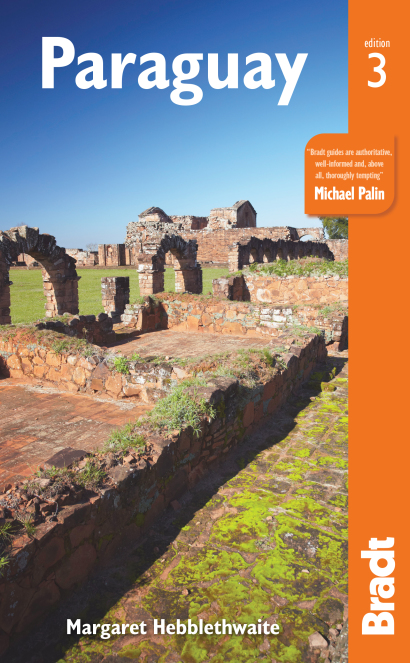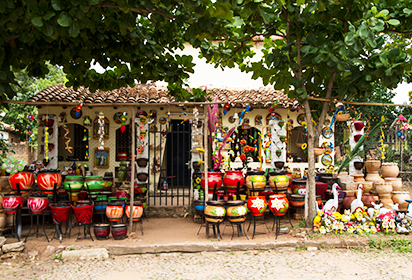You do not want to tell other people about it, for fear of spoiling it for yourself. And yet, at the same time, you do want to spread the word because you love it so much.
Margaret Hebblethwaite, author of Paraguay: the Bradt Travel Guide
The bicentenary celebrations of Paraguayan independence in 2011 prompted a ‘face-lift’ of the capital city, Asunción, and there has been a rapid growth in facilities for visitors since then. The city now has a burgeoning bar and café scene, while its eastern counterpart, Ciudad del Este, is a neon-swathed boomtown.
Yet dig a little deeper and a different picture emerges: Jesuit ruins echo with centuries of history, rural families keep craft traditions alive and everything stops as people share a leisurely drink of tereré.
And beyond lies the country’s incomparable natural beauty, from the wild wetlands of Ñeembucú with herons flying overhead to the vast arid grandeur of the Chaco with its jaguars and bottle trees.
You can explore savannahs dotted with palm trees and red-earth roads, empty river-beaches, damp Atlantic forests, or the wild Chaco’s ‘green desert’, all without running into another foreigner.
You can swing in a hammock chugging slowly upriver, and enjoy some of the best birdwatching in the world. Folk dance, harp-playing and handicraft – particularly in lace-making and filigree silver jewellery – are vibrant, living traditions.
This is still a bilingual nation, with Guaraní spoken alongside Spanish – its character shaped by the legendary Jesuit missions with their romantic ruins and fine sculptures of saints, where the indigenous remained protected from European exploitation for over 150 years.
Paraguay is an emerging tourist destination. It is rapidly improving its facilities but is still mercifully free from tourist tat, and it remains a country with its own traditional culture. Discover it now while it is still authentic.
For more information, check out our guide to Paraguay:
Food and drink in Paraguay
You can eat very well in Asunción, and even vegetarians will find plenty of good salads to fill their plates, even (indeed, especially) in the churrasquerías (restaurants serving roast meals). But most restaurants and bars in the interior of the country are very basic. Every town will have a bar which serves empanadas (like cornish pasties) and milanesas (escalopes), beer and fizzy drinks, and not much else. Most ordinary restaurants serve a small variety of meat dishes, accompanied by chips, rice salad, potato salad or a mixed salad (lettuce, tomato, onion), and it is usual to skip dessert entirely.
Petrol stations are good places to find cheap and readily available food, as many are open 24 hours and serve hot dogs (panchos), croissants (media lunas), capuccinos and other fast foods. A super pancho is a long hot dog with fillings of onion, sweet corn, cabbage, etc. Youths who go out at night in Asunción to bars or night clubs often finish with breakfast in a petrol station.
Many of the European staples are missing in Paraguay. It is not a tea country, or a coffee country, or a wine country; it is not a bread country or a cheese country. You can get good wine readily (imported from Chile and Argentina), and Hornimans do a Classic London Blend of tea. However, it is difficult to get good coffee, bread or cheese outside of good restaurants and specialised shops in Asunción. Instead of tea and coffee, the people drink tereré or cocido. Instead of wine they drink beer or gaseosa (fizzy drinks). They may drink a jugo (fruit juice) with their meals: these delicious mixtures blend fresh fruit with extra water and sugar, to make a longer drink in this thirsty climate. Instead of bread, mandioc or sopa paraguaya or chipa is eaten.
Health and safety in Paraguay
Health
Travel insurance is important in the developing world, to cover for health problems (including flying you home if that is advised), as well as for accidents, theft, loss of luggage and mishaps generally. It is also recommended to carry a written note of your blood group with you – it is standard for Paraguayans to have this information shown on their driving licences – and also written information about any health condition you may have (eg: diabetes) and any medicines you need to take regularly.
The only vaccine required under the International Health Regulations to enter Paraguay is yellow fever, if you are one year or older and are coming from or passing through an endemic area. – which includes all those changing planes in São Paulo.
Travel clinics and health information
A full list of current travel clinic websites worldwide is available on www.istm.org. For other journey preparation information, consult www.travelhealthpro.org.uk (UK) or http://wwwnc.cdc.gov/travel/ (US). Information about various medications may be found on www.netdoctor.co.uk/travel. There are also regular updates to help you prepare for your Paraguayan trip on our dedicated health page. All advice found online should be used in conjunction with expert advice received prior to or during travel.
Safety
As is well known, where there is poverty, the crime rate is higher. In Asunción and the other cities, particularly Ciudad del Este and Pedro Juan Caballero, you need to be careful and take a few simple precautions. When you arrive at any airport, go to the taxi rank, where all the drivers are known and registered, or to a window which says ‘Taxis’. In the case of Asunción Airport, the official taxis are no longer the yellow ones that you find in the rest of the city, but smarter cars that have been selected for their greater comfort. They are not recognisable as taxis, and there are officials at the door who are responsible for seeing that travellers get directed to an approved taxi.
Do not go into the poorest areas of cities, even by day and even with a companion, unless that companion is someone known to the local people. This applies to the bañados in Asunción – the areas along the riverbank which get periodically flooded, and where there are only hovels. It also applies to a lesser extent to some of the adjacent barrios to the bañados such as Barrio Republicano.
Some people make a point of always travelling by taxi after dark, in the cities. This is a matter of individual decision, and others consider it excessively cautious and expensive. Avoid crossing open spaces, especially at night: it is better to walk around a deserted square at night than to walk through it, where passing cars and pedestrians would not witness any problem or assault. It is probably better not to go for a walk in the Parque Caballero in Asunción even by day. Avoid unpopulated streets, or at least be alert to who might be following you, crossing the road to avoid isolated male walkers. Thieves work alone sometimes, but often they operate in groups.
Be careful in public buses: a lot of theft occurs in them. There is no need to avoid taking buses, but be cautious if the bus is either very full or empty. Although it is unlikely you will have any trouble, be aware that from time to time problems can occur. Pockets can be picked, handbags can be sliced into with sharp knives, and jewellery can be snatched from your neck, so for extra safety put pendants inside your clothes. Smartphones are particularly desirable. Do not expect the other passengers or driver necessarily to assist you in the case of an attempted theft: they may be at risk of reprisals.
Do not wear a money belt around your waist, unless it is well hidden and does not protrude. Otherwise all it does is announce to the thief where the valuables are, and make an assault more likely. Paraguayans will hide their money in their socks or bra rather than in a money belt. Split up your money, so if you are robbed you have at least a little emergency money in another place. It is a good idea to also carry a smaller amount of money in a secondary wallet, that you can hand over with less serious loss if assaulted. Paraguayan thieves are not usually interested in credit cards and do not know how to use them: all they want is cash, jewellery, mobile phones and other electrical devices,so be very careful if you get out your smartphone in the street.
Female travellers
There are no special rules for women travellers. Although Paraguayan men can be pushier than European men, there is no particular safety risk for women, and it is not necessary for women to be escorted or to dress differently from how they would at home.
Travel and visas in Paraguay
Visas
Visitors from the UK and most EU countries do not require visas, but they are required for visitors from most African countries (but not South Africa or Morocco), some Middle Eastern countries (but not Turkey, Jordan, Lebanon or Egypt), and some Asian countries including China (but not Japan, Korea, Vietnam, Indonesia or the Philippines).
Nationals of Canada, the USA, Australia, New Zealand, Russia and Taiwan can buy what is called a visa de arribo when they arrive at Asunción airport: the price depends on the country of origin but currently varies from US$100 (Taiwan) to US$160 (USA). Do not forget that you will probably be going to the Iguazú Falls, which are just outside the Paraguayan boundary, so you need to think about Argentina and Brazil as well.
A normal tourist stamp when you enter the country will last for 90 days. If you want to spend longer than this in Paraguay, you can renew the stamp once for a further 90 days quite easily by going to Migraciones in Asunción and paying a fee (currently Gs340,185 or approximately US$60). There is no problem about doing this: Paraguay likes to have foreigners in the country who bring in money, and likes to collect fees from them, but they may ask you to come back the next day to collect your passport, which could be a nuisance if you are not staying in Asunción.
Alternatively, you can over-run your time and pay a small fine when you leave the country (currently Gs235,515 or approximately US$42, so this is the cheaper alternative, illogically). A third option is to make a short trip over the frontier and get a new stamp (but if you go to the Iguazú Falls make sure they actually do stamp your passport, as they will prefer to wave you through without doing so, and then you will be fined on departure from Paraguay). What is not advised is to get a visa for a longer stay: it will take you time, money and frustration to assemble all the necessary documents, and when you arrive in the country the passport officer may give you a 90-day tourist entry stamp anyway. When you leave the country after your 90 days you will then be fined, even though you paid for a visa. At least, that has been the experience of some travellers.
Getting there and away
By air
Paraguay is a cheap country to holiday in, but is not a cheap destination to fly to, because there are no direct intercontinental flights other than Air Europa from Madrid. People usually change in São Paulo. Buenos Aires is also an option for changing, particularly if you are coming from Australia. The name of the international airport in Asunción is Silvio Pettirossi.
The airfare varies according to season: high season is July, August and December. The flight schedule is always changing, so you need to check on the situation when your time comes to travel. Air traffic to Asunción has increased dramatically, with now more than 50 operations per day, despite the fact that American Airlines, which had left Paraguay and then returned, have now left again. The Bolivian airline, Amaszonas (no, it is not a misprint), has grown very fast since it began selling e-tickets in 2005, and is now one of the principal airlines serving Asunción. Air Europa have announced that due to good passenger numbers they will increase the frequency of their flights to Madrid to daily, by 2019. GOL has diminished with regard to Paraguay, but is in the process of changing its image from a low-cost airline to a quality one. BQB has closed down. LATAM is the new amalgamation of TAM with LAN.
If you are travelling from London, the route preferred by most people at present is either LATAM via São Paulo (daily), or Air Europa from Madrid (twice weekly, Mon & Thu) starting from London Gatwick. The best-known specialist travel agency in the UK for Latin American flights is Journey Latin America (page 32). LATAM is a good airline and is part of the Oneworld alliance (with British Airways and other major airlines). Air Europa is a low-cost airline, with the inevitable limitations that that puts on quality. If you are travelling to Paraguay from the USA, then LATAM is also a good option.
Bear in mind that the morning flights from São Paulo to Asunción are sometimes booked out about three weeks in advance, so it is worth booking ahead if you want to avoid waiting all day in São Paulo until the less busy evening connection.
If you are going to more than one place in South America, you should find out about airpasses, which can offer you more economical prices if you are taking several flights, but you may need to purchase your pass in advance overseas, in conjunction with your intercontinental flight, so you should think about this from the start. The Oneworld South American airpass seems to be taking over from the Mercosur airpass which was popular in the past. But this may be an area where you need the advice of a good travel agent.
When to visit Paraguay
Visiting Paraguay at any time of year you are likely to have good, sunny weather. However, some months are a bit unpredictable, so if nothing else is determining the time of your trip, here are some factors to bear in mind. December to February are the hottest months and June to August are the coldest ones. By the middle of September the cold weather is over. If you are looking for temperate weather, therefore, the ideal time to come is between September and early December (before the fares go up for the pre-Christmas rush) or between late February and May.
Over Easter would be ideal if it were not the time when all the Paraguayans are enjoying their holiday of Semana Santa, which is Maundy Thursday to Easter Sunday. Easter Monday is back to work. Book your hotel ahead for those crucial three days if you want to be in Paraguay over Easter, and be prepared for everywhere to be closed. If you cannot come in spring or autumn it is up to you to decide if you prefer to be hot or cold. Paraguayans have a long summer holiday from December to February, and in January those who can afford it tend to go to the Brazilian beaches, or to the Paraguayan beaches of San Bernardino, Villa Florida or Ayolas.
Educational institutions also have a short winter break in the first fortnight of July (la quincena de julio). The weather in July is very variable: it can be as agreeable as an English summer, but there is also the risk that it may be unpleasantly cold, and with every year’s increasing climate change, the cold snaps of winter are becoming more frequent and more bitter. The old wisdom used to be that July was a good month to come, because it would not be too hot (average temperatures in Asunción in July are 10–22°C), and that if there was cold weather it would last only three or four days. With climate change, that needs to be re-assessed. June and August are generally all right, but cannot be guaranteed.
Climate
The climate of most of Paraguay is subtropical. According to the official dates, spring is 21 September to 20 December, summer is 21 December to 20 March, autumn is 21 March to 20 June and winter is 21 June to 20 September. Although there can be long periods of drought, fatal for the crops, there is generally a good level of rainfall, producing a very green landscape. The rain most typically falls in violent thunderstorms, which are not infrequent.
The average maximum temperature is 36°C in January (the hottest month) in the Chaco (Mariscal Estigarribia), and 32°C in Encarnación (the most southerly city). The average minimum in those two places in January is 23°C and 20°C respectively. In July (the coldest month) the average maximum temperature is 26°C in Mariscal Estigarribia, and 21°C in Encarnación. The average minimum in those two places in July is 12°C and 9°C respectively.
What to see and do in Paraguay
Areguá
Areguá must be one of the best towns to visit in a Circuito de Oro tour. It is one of three craft towns specialising in ceramics, and is the nearest to Asunción. (The others are Itá and Tobatí.) It is a lovely town, marked by an elegant church at the top of the hill and splendid colonial-type houses on the Avenida Estigarribia leading up to it. It is increasingly regarded as a prestige town, bursting with little art galleries, that merits the preservation of its architecture. A number of artists and writers have made their home here, including the distinguished novelist Gabriel Casaccia, whose striking novel La Babosa is set in the town.
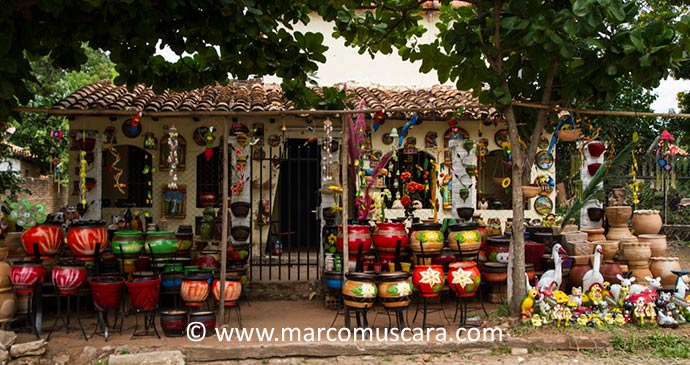
There are streets lined with craft shops selling ceramics, with much in the way of attractive, large, unglazed flowerpots and pretty small candleholders with holes for the light to shine through. However, there is also a lot of moulded clay work that is less pleasing to European and North American taste, such as garden gnomes, along with frogs, tortoises, swans and toadstools. Another variety of mass-produced moulded clay is their typical line in crib figures, which come out in force in the pre-Christmas period, although a few artists are now beginning to make original hand-formed figures.
The chief founder of the pottery tradition was Ricardo Pérez, a late 19th-century potter who lived in the southern Chaco, and helped General Bernardino Caballero (war hero of the Triple Alliance War and founder of the Colorado party) to escape his enemies by hiding him in his big kiln and faking a fire inside. In gratitude, Caballero gave him territory in Areguá to establish a bigger pottery business.
The fiesta patronal (feast day of the town’s patron saint) is on 2 February, the feast of Candlemas. Throughout February they have now begun to hold a fair for mangoes and food produced from mangoes. Another tourist attraction is the Expo Frutilla, or Strawberry Fair, mid August to the end of September, though strawberries are plentifully available for sale before that, from July or even the end of June. The strawberry stalls are to be found principally along the road leading to Ypacaraí, where there is a compañía of Aregua, called Estanzuela, 2km from the town centre.
Asunción
Asunción is not one of Latin America’s loveliest cities, though it grows on you. A certain amount has been done in the last few years to clean buildings, remove over-large hoardings, widen pavements and install pergolas, benches and period streetlamps in the key areas of the city centre.
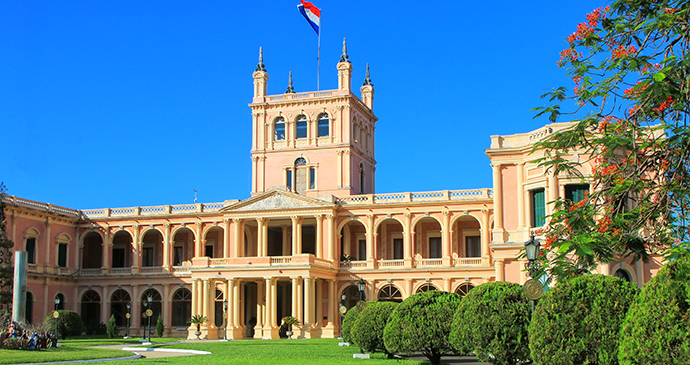
There has also been a splash of imaginative, colourful murals since the Latido Americano Paraguay festival that came to the city in August 2016, uniting nine Paraguayan artists with 31 from other Latin American countries. There is much more to be done, as many fine 19th-century buildings are in a state of near collapse, but could be magnificent if restored. However, a start has been made, in the renovated Casas del Bicentenario. If you know where to go, you can find a lot of great interest and a little of great beauty.
As the capital, Asunción brings together the best artistic and intellectual life of the country, and a cultural and political awakening is undoubtedly taking hold, particularly among young people. It can be seen in the recent political protests, summoned through social networks, and in the rise of a new wave of design that is simultaneously more modern and more heritage-based.
There was an artistic creativity and an inspiring eloquence in the peaceful street demonstrations that followed the 2012 coup, and there is still a tangible buzz in the air – influenced inevitably by the northern hemisphere, but nonetheless with a pride in distinctive Paraguayan culture.
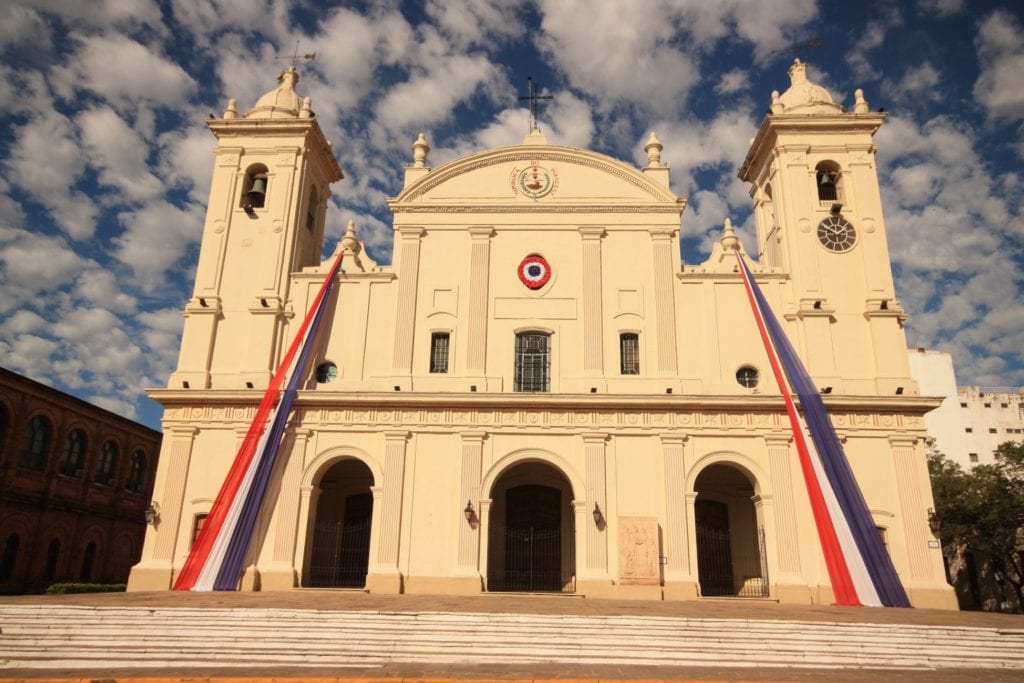
At the same time, economic growth over the last five years has resulted in a plethora of innovative new bars and restaurants. Seen at its worst, Asunción has roads and pavements in terrible condition, rubbish littering the streets, and children in ragged clothes begging on buses. BBC journalist Tim Vickery once wrote: ‘The place and the people have a certain serene charm, but one of the abiding impressions is of mangy dogs snoozing on shattered paving stones.’
But seen at its best, Asunción is immensely rich in green spaces, with plazas, parks, the Jardín Botánico and the Costanera. Particularly good places for walking are the new coast road and the Parque de la Salud. It is always a joy when some of the trees are blossoming, with the pink of the national tree, the famous lapacho (tajý in Guaraní), the yellow of another variety of lapacho, the red of the chivato, and the blue of the jacaranda. The blossom is seen not only in spring but whenever a burst of warm weather misleads the trees into thinking spring has arrived.
Caazapá
Caazapá is one of the earliest and most important of the former Franciscan Reductions, and was founded by Friar Luis Bolaños himself in 1607 (two years before the Jesuits founded their first Reduction at San Ignacio Guazú). When you arrive in Caazapá, you may gasp in delight at finding such an attractive town so deeply hidden in the countryside. At the initial little roundabout you are welcomed by a statue of Luis Bolaños, simply attired in his Franciscan habit and carrying a cross and a staff.
From here a splendid avenue of palm trees leads to the plaza and the church, with its stunning reredos. To the right is the cemetery where there is a smaller and older chapel, also with an original reredos. To the left the road leads on to the famous spring, Ykuá Bolaños – a name unfortunately now linked in everyone’s mind with the tragic fire at the Ycuá Bolaños supermarket in Asunción in 2004, when 400 people died.
There are still very poor areas in the countryside around the town, but a number of better-off politicians, lawyers and businessmen have property in the area, with the result that Caazapá appears a surprisingly well-kept and well-off town. It was well off even as a Reduction, because of its excellent cotton and tobacco production, and the decoration of the church was as fine as those of the Jesuits, while the quantity of gold exceeded the Jesuit churches. (This is reported by Félix de Azara, the Spanish naturalist and military officer who was sent in 1781 to determine the border dispute between the Spanish and Portuguese colonies.)
Cerro Corá National Park
Because Cerro Corá is regularly visited, it is not necessary to follow the general rule for visiting the national parks, which is to contact SEAM (Secretaria del Ambiente) beforehand in Asunción. This famous but remote park is best known for being the site of Mariscal López’s death and the country’s final capitulation in the Triple Alliance War. But, in fact, it includes two other attractions: a pleasant nature walk to Cerro Muralla, and the eco-archaeological reserve of Gasorý, where there are cave writings.
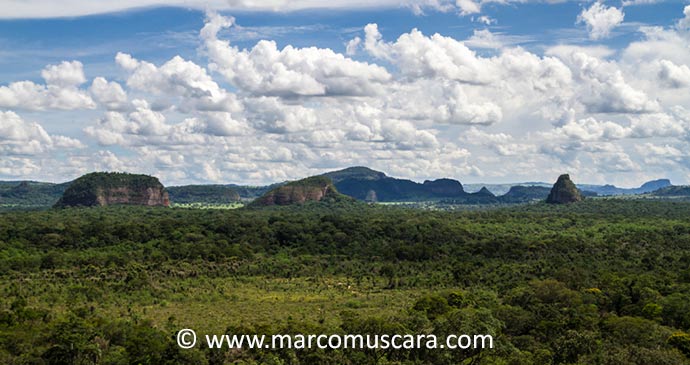
There is also a pleasant beach on the shores of the Río Aquidabán. The park protects the Cerrado ecosystem and the famous bellbird or pájara campana can be found there. It covers more than 12,000ha and was declared a national park in 1976. It is visited by 9,000 people a year, of which 40% are foreigners.
Iguazú Falls
The Iguazú Falls are one of the wonders of the world. Going to see a waterfall might not sound like a full day’s occupation, but that is the very minimum that you need for Iguazú, and two days is still not enough for an exhaustive visit. The size, power and variety of these falls is breathtaking. They are in the region known as the Three Frontiers, where Paraguay, Argentina and Brazil meet, but the falls today are just outside Paraguayan territory, forming the border between Brazil and Argentina.
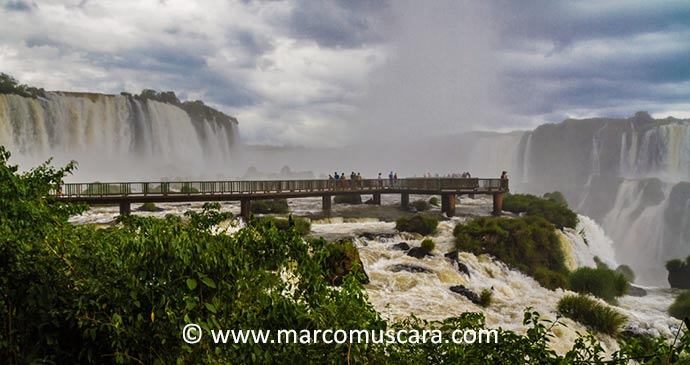
Few visitors to Paraguay want to go home without seeing them. In the time of the President Dr Francia, there were border disputes over Misiones Argentina, but Paraguayan claims were ended by the disaster of the Triple Alliance War. Paraguayans still, however, feel a certain affinity with this territory, especially since the falls have a Guaraní name. Guaraní is still spoken as the mother tongue in Paraguay while it has been virtually lost in Argentina and Brazil as a living language, with only place names surviving.
Most people who go from Paraguay to the Iguazú Falls (or las Cataratas as everyone calls them) travel to the Paraguayan border city of Ciudad del Este and then cross over to Foz do Iguaçu in Brazil. This is the most direct route.
Jesuit museums of Misiones
Stretches of cream sand extend before your eyes, depending on the river level. You are now in the famous Misiones departamento, or the mission territory of the Jesuit Reductions – which also continue into the next departamento of Itapúa. The basic rule is: museums in Misiones, ruins in Itapúa. These two departamentos are Paraguay’s top tourist attractions – the land of what is often called ‘The Lost Paradise’ or ‘The Forgotten Arcadia’. Given their distance from Asunción, you need a minimum of two or three days to visit them, and five or six days to do them justice.
There are four Jesuit Reductions in this departamento: San Ignacio, Santa María de Fe, Santa Rosa and Santiago. There were once 30 such towns in the most developed, settled period of the Reductions, and they were known as the Treinta Pueblos (Thirty Towns). Founded on both banks of the Río Paraná and both banks of the Río Uruguay, today they stretch from Paraguay through Argentina and into Brazil.
On the way to them you pass through some other attractive towns that were not Reductions, though they fell within the lands of the old Reductions and began as outposts or chapels on the estancias. Later they developed into urban centres in their own right. Of these, Villa Florida, with its beaches on the river, is a Paraguayan holiday town; San Miguel, with its woollen craft, is a popular tourist stop; and San Juan is the capital of the departamento.
Ñeembucú
Tucked away in the southwestern tip of eastern Paraguay, Ñeembucú is one of the wildest and most beautiful areas of Paraguay, and one of the least visited. The access point is San Ignacio. It also has the advantage of comfortable fast buses running from Asunción to Pilar, and a number of new posadas turísticas recognised by Senatur. Pilar, the capital of the departamento and the gateway to the other places of interest, is a good hour and a half from the international highway Ruta 1, and is reached by Ruta 4, which is asphalted. At Pilar, the asphalt runs out.
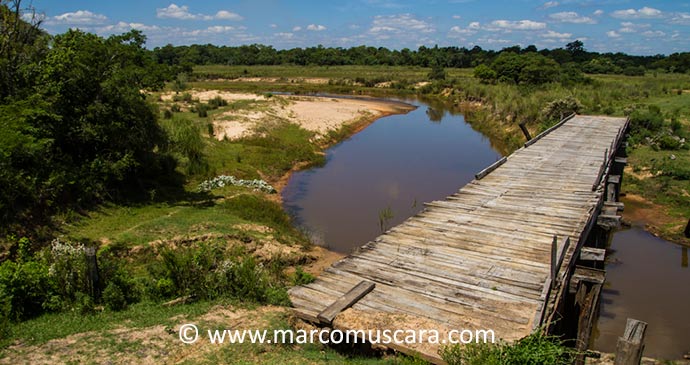
If you want to get away from people and into nature, Ñeembucú is a great place to go. Only in the remote northern Chaco will you find a departamento more sparsely populated. In its low-lying savannahs and wetlands, bordered on two sides of a triangle by the rivers Paraguay and Paraná, the marshes of Ñeembucú are as important as they are unknown. The birdlife is stunning, and even the least bird-aware of visitors will be enchanted by the sight of egrets (white herons) winging above them.
There are plenty of roadside hawks, southern crested caracaras, black vultures, southern lapwings, spotted nothuras, neotropic cormorants, and picazuro pigeons. Birdwatchers will want to stop and get out their binoculars where the wetlands start, as close as 20km from San Ignacio. Unfortunately, it is difficult to do this unless you are travelling by car, as the buses do not generally stop on the 1½ hour drive through empty countryside between San Ignacio and Pilar.
As evening draws in, the birdsong most heard is from the giant wood-rail, the limpkin and the famous southern screamer, which is found only in South American swamps. It is a huge, heavy, distinctive bird, and its wingspan of 170cm makes it a noisy bird in flight. It has a red surround to the eye, a crest of feathers at the back of the head, black and white rings around its neck, red legs and partially webbed feet. It is usually found in pairs, and the couples, which share the incubation of eggs, are so faithful that when one of the pair dies the other often dies too. Its cries of chahã can be heard up to 3km away, earning it its Guaraní name.
The Pantanal
More than 60 million years ago, the centre of South America was a sea. This explains why there are still expanses of salt lakes in the Chaco. Movements of the earth’s surface led to the formation of the Andes, and the north–south depression to the east of that range is the Pantanal. It is the flat land around the Río Paraguay, of which 70–80% floods in the rainy season, from December on, raising the water level by some 5m. This makes it become enormously fertile territory for flora and fauna, but very inhospitable for human beings. The average temperature is 32°C in summer and 21°C in winter.
In the time of the Jesuit missions the Pantanal was called simply La Laguna. The Pantanal is principally associated with Brazil, but in fact 5% of this territory is in Paraguay. The Pantanal is considered one of the most important and beautiful ecological sanctuaries of the planet. The tall karanda’ý palm with its fan-like leaves abounds, and the karaguatá is a low-growing bromelid with bright-red, thorned leaves and white flowers. The pink ipés blossoms on trees, the aguapé (Spanish camalote) fills the waters with a green carpet and keeps the waters fresh, and the huge 30cm wide flowers of the Victoria Regia open at night. There are water hyacinths, water lilies and water lettuces.
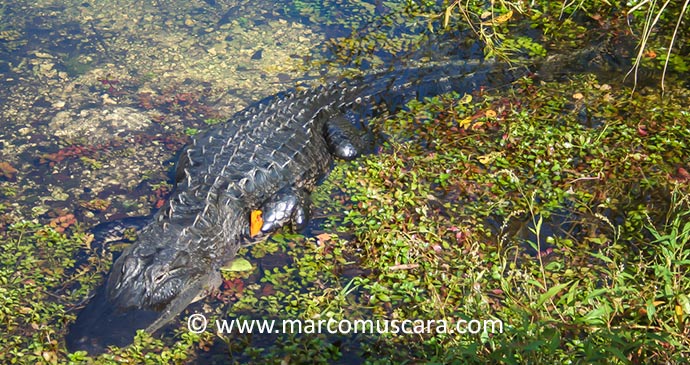
The Pantanal has the largest faunal concentration in the Americas, and has been estimated to contain 650 species of birds, 260 of fish, 160 of reptiles, 80 of mammals and 6,000 of insects, not to mention 1,800 species of plants. Emblematic of this paradise of flora and fauna is the jabiru stork, which has a black head and neck and a red collar, and a wingspan of 2m. It feeds richly on the fish, frogs and insects left behind by the floods. The marsh deer has long, wide hooves with a membrane between its toes, so it can run on the swampy ground. There are caimans, lizards and iguanas, tapirs, wild pigs (or peccaries), coati, the paca rodent, eight species of armadillo, and all five species of Paraguayan monkey. The handsome and dangerous jaguars are the most striking of all the animals. The bird life is spectacular, with herons, ducks, cormorants, scarlet ibis, spoonbills and toucans, and there is the world’s largest population of blue hyacinth macaws.
The early hours of the morning and the last hours of daylight are when there is most activity from the birds. The density of human population in the Pantanal is only 0.14 per km²; the population includes a small number of Chamakoko indigenous (also known here as the Ishir). For a detailed guide to the fauna and flora of the Pantanal, see Bradt’s Pantanal Wildlife.
Trinidad and Jesús
Trinidad
Trinidad is the most evocative of the ruined Jesuit-Guaraní sites due to its wonderful surviving stone carvings, and the magical isolation of the site. One of the advantages of the Paraguayan Mission route being less frequented than the Argentinian and Brazilian Reductions is that it leaves more room to dream and less room for tourist tat. Brazil’s tourist infrastructure in Missões is very tasteful, and Argentina’s is quite pleasant, but there is nothing quite like the experience of standing alone on the brink of Trinidad’s vast plaza, and then setting off to explore.
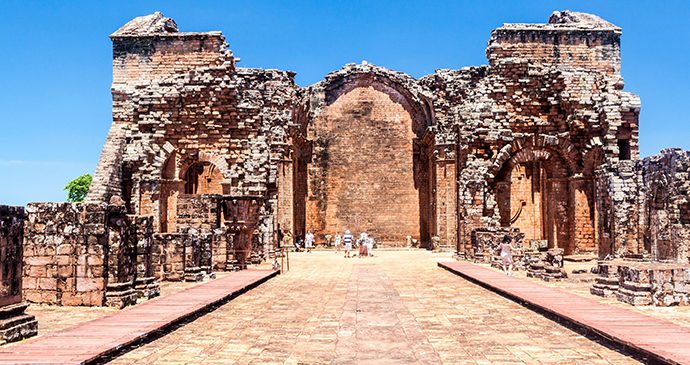
You begin by walking through the arched colonnades of the casas de indios and crossing the huge expanse of grass towards the big church on the far side; then make your way up the nave, past the souls in the flames of purgatory on your right where the Guaraní kept night watch over their dead, past the great pulpit of the four evangelists on the left where sermons were preached in the native tongue, and into the sanctuary. There, high above your head, but clearly discernible, 46 angels play the music of heaven, just as the Guaraní had played the same instruments in the church.
Jesús
The ruins have a lovely setting, being on higher ground, with vistas of palm trees framed through the windows, and there is something almost Cistercian about their isolation and austerity. There are about 100 visitors a week to the Ruins at Jesús – around a quarter of the number that visit Trinidad.
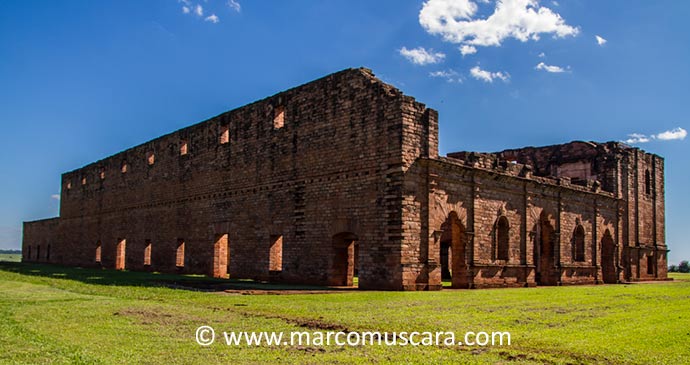
The church and the college are the principal remains in this peaceful spot with its dramatic columns and vistas, though you can also pick out something of the whole layout of the town, according to the typical design of a Reduction. There is a plan on your left as you enter, mapping out the cemetery (to the left of the church), the orchard (behind it), and priests’ house, college and workshops (to the right). The casas de indios were arranged in rows around the plaza, which no longer exists as a plaza, but is the long grassy space you cross before reaching the church, where you can rest halfway in the shade of some trees.
Yaguarón
Yaguarón is famous for being the only Reduction to have its original church still standing in its original form. This is a ‘must-see’ if you are interested in the Reductions, and although the Reduction is Franciscan, the church is on exactly the same model as in the Jesuit Reductions. If you are not in your own transport, you see it out of the window of the bus as you go through the town, travelling towards Asunción. (Travelling southwards, however, the one-way system does not lead you past it.)
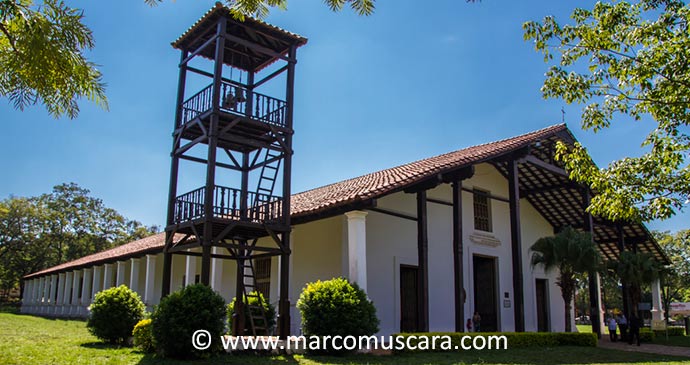
It is highly distinctive with its simple pitched roof, massive wooden columns and separate wooden bell tower, and is clearly visible on the north side of the Ruta, which curves around it. But if you can manage to stop and go inside, do not miss the opportunity to see this gloriously harmonious extravaganza of painted and carved wood.
Fray Luis Bolaños and Fray Alonso de San Buenaventura, his missionary companion, founded Yaguarón shortly after Itá, around 1586–87,although an indigenous settlement existed there already, apparently founded by the conquistador Domingo Martínez de Irala in 1539. Today, Yaguarón still has an interesting band, called Peteke Peteke, that plays traditional, indigenous music on old instruments such as the turú (cow’s horn) and different sizes and shapes of drums. It traditionally plays on 3 February (feast of San Blas), 16 August (feast of San Roque) and the first Sunday of September.
There are two theories of the derivation of the town’s name. Either it comes from the Guaraní jaguar (father of a dog), indicating that a huge and fearsome dog used to menace the place, or from the name of a respected cacique (chief), Ñaguaru.
Related books
For more information, see our guide to Paraguay:
Related articles
The Circuito de Oro is a must-see for any visitor to Paraguay.
From the rolling fields of the campo to the craft towns of the Circuito de Oro, Paraguay is a place of great contrasts.
